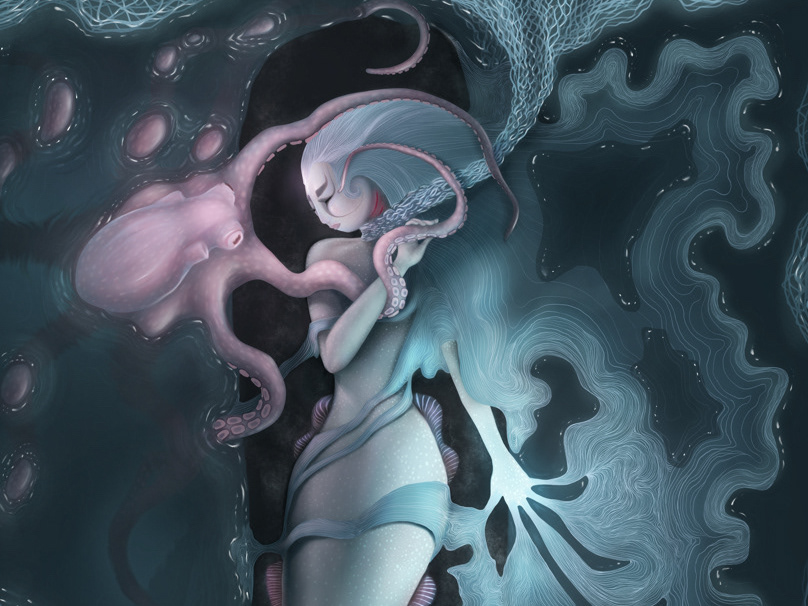Many cultures have a concept of a Mother of Waters. In Latvian indigenous mythos, they have a series of animistic beings called the Māte (meaning the Great Mothers). This includes Mother of the Sea (Juras māte), Mother of Waves (Bangu māte), Mother of Rain (Lietus māte), and Mother of Rivers (Upes māte). Rather than believing in these entities as literal goddesses or beings, it is more about recognizing the beingness of bodies of water. Naming them and conceptualizing them as mothers helps us humans relate to them, but they have their own specific beingness that is wholly different from that of people, with its own power, will, and animistic consciousness.
For example, Upes māte (Mother of Rivers) has a voice, but she doesn't have a human voice. But the riverbed is like a larynx, and the water passing over it and the sound it makes is like air passing through our throat to create a voice. The voice of the river (and hence the voice of Upes māte) is the sound of the water as it flows. If you go to the river, it can be easy to tune out this sound (as it falls in the category of 'white noise') and start daydreaming. But if you really focus on listening to that sound, you are hearing Upes māte. What does she say? It might be hard to relay without words, allegories, similes, or symbols, but that's okay - these elements help translate nature's raw language into a cohesive narrative we can more easily relate to.
And so that's what this drawing is: a depiction of a watershed, taking on a human form. In a way, this is my idea for a Mother of Watersheds (ūdensšķirtne māte) which doesn't exist in the Latvian pantheon, but that is what I love about working with ancient concepts and symbologies: we can keep them alive by adding to them, conversing with them, and creating new concepts using ancient tools and ways of understanding.
On watersheds:
A watershed is an area that channels rainfall and mountain snowmelt into creeks, streams, and rivers, and eventually to an outflow point such as a lake, sound, or ocean. This is a sacred process through which water touches almost all life forms in some way, and there's quite a bit of symbolism in the journey the water makes.
71% of the earth's surface is water. On average, 70% of the human body is made up of water. Your body's waters align with the watershed you're in, and when you travel, it takes about three days for your body's waters to be replaced by the waters of a new watershed. But no matter where we are, we are our watershed.
We are water.
Muchas culturas tienen un concepto de Madre de las Aguas. En los mitos indígenas de Letonia, tienen una serie de seres animistas llamados Māte (que significa Grandes Madres). Esto incluye a la Madre del Mar (Juras māte), la Madre de las Olas (Bangu māte), la Madre de la Lluvia (Lietus māte), y la Madre de los Ríos (Upes māte). En lugar de creer en estas entidades como diosas o seres literales, se trata más de reconocer el ser de los cuerpos de agua. Nombrarlas y conceptualizarlas como madres nos ayuda a los humanos a relacionarnos con ellas, pero tienen su propio ser específico que es completamente diferente a lo de las personas, con su propio poder, voluntad y conciencia animista.
Por ejemplo, Upes māte (Madre de los ríos) tiene voz, pero no tiene voz humana. Pero el lecho del río es como una laringe, y el agua que pasa sobre él y el sonido que hace es como el aire que pasa por nuestra garganta para crear nuestra voz. La voz del río (y por lo tanto la voz de Upes māte) es el sonido del agua mientras fluye. Si vas al río, puede ser fácil dejar de escuchar este sonido (ya que entra en la categoría de 'ruido blanco') y empezar a soñar despierto. Pero si realmente te enfocas en escuchar ese sonido, estás escuchando a Upes māte. ¿Qué dice ella? Puede ser difícil transmitir sin palabras, alegorías, símiles, o símbolos, pero está bien: estos elementos ayudan a traducir el lenguaje crudo de la naturaleza en una narrativa cohesiva con la que podemos relacionarnos más fácilmente.
Y eso es lo que es este dibujo: una representación de una cuenca, tomando forma humana. Así creí una Madre de la Cuenca (ūdensšķirtne māte) que no existe en el panteón de Letonia, pero eso es lo que me encanta de trabajar con simbologías antiguas: podemos mantener esos conceptos vivos al agregarnos a ellos, conversando con ellos, y creando nuevos conceptos—una nueva simbología—usando herramientas antiguas y sabiduría ancestral.
Acerca de las cuencas:
Una cuenca es un área que canaliza el deshielo de la montaña y la lluvia hacia riachuelos, arroyos, y ríos hacia un punto de desagüe, como un lago, un estrecho, o un océano. Este es un proceso sagrado a través del cual el agua toca casi todas las formas de vida de alguna manera, y hay bastante simbolismo en el viaje que hace el agua.
El 71% de la superficie terrestre es agua. En promedio, el 70% del cuerpo humano está compuesto por agua. Las aguas de tu cuerpo se alinean con la cuenca en la que te encuentras y, cuando viajas, las aguas de tu cuerpo tardan unos tres días en ser reemplazadas por las aguas de una nueva cuenca. Pero no importa dónde estemos, somos nuestra cuenca.
Somos agua.









